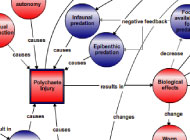|
|
|
|
Click Buttons for Science Background, Map & Poster |
About Concept Mapping:
Concept maps are graphical tools that highlight fundamental concepts and the types of connections between concepts within complex systems. Educators can use concept maps to assess how students develop understanding. For example, students and educators can modify maps to reflect changes in the scope and depth of their understanding. The concept map on this page was created using the COSEE-OS Concept Map Builder. Content from this map will eventually be integrated into the COSEE-OS Ocean Climate Interactive.
About this Student:
Beth Campbell is a graduate student in the School of Marine Sciences at the University of Maine. She has a B.S. degree in Marine Biology, also from the University of Maine, and taught classes at John Bapst Memorial High School prior to beginning her graduate work. Her thesis project with Dr. Sara Lindsay will focus on marine polychaetes.
Beth has participated in three COSEE-OS workshops: the 2006 Educators Institute (Seasons in the Sea: Understanding Change in the Gulf of Maine Through Buoys, Boats, and Satellites) at the University of New Hampshire and Teaching Science by Ocean Inquiry, held at the Darling Marine Center (DMC) in 2007, and the 2010 Graduate Student / Faculty Collaborative at the DMC. Beth's passion for both education and marine biology makes her a great collaborator for COSEE-OS as she pursues her degree.
Concept maps are graphical tools that highlight fundamental concepts and the types of connections between concepts within complex systems. Educators can use concept maps to assess how students develop understanding. For example, students and educators can modify maps to reflect changes in the scope and depth of their understanding. The concept map on this page was created using the COSEE-OS Concept Map Builder. Content from this map will eventually be integrated into the COSEE-OS Ocean Climate Interactive.
About this Student:
Beth Campbell is a graduate student in the School of Marine Sciences at the University of Maine. She has a B.S. degree in Marine Biology, also from the University of Maine, and taught classes at John Bapst Memorial High School prior to beginning her graduate work. Her thesis project with Dr. Sara Lindsay will focus on marine polychaetes.
Beth has participated in three COSEE-OS workshops: the 2006 Educators Institute (Seasons in the Sea: Understanding Change in the Gulf of Maine Through Buoys, Boats, and Satellites) at the University of New Hampshire and Teaching Science by Ocean Inquiry, held at the Darling Marine Center (DMC) in 2007, and the 2010 Graduate Student / Faculty Collaborative at the DMC. Beth's passion for both education and marine biology makes her a great collaborator for COSEE-OS as she pursues her degree.








